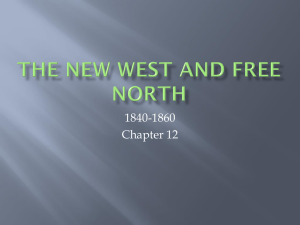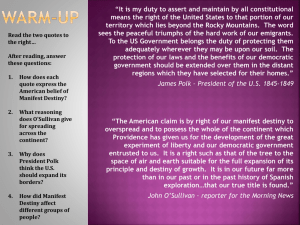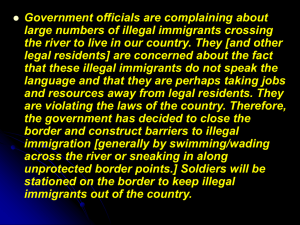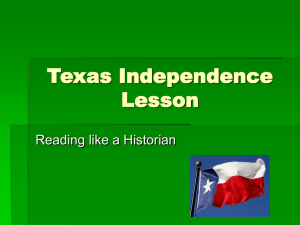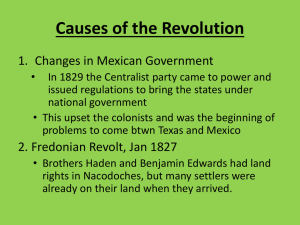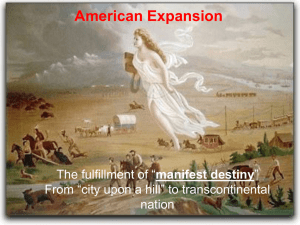docx
advertisement
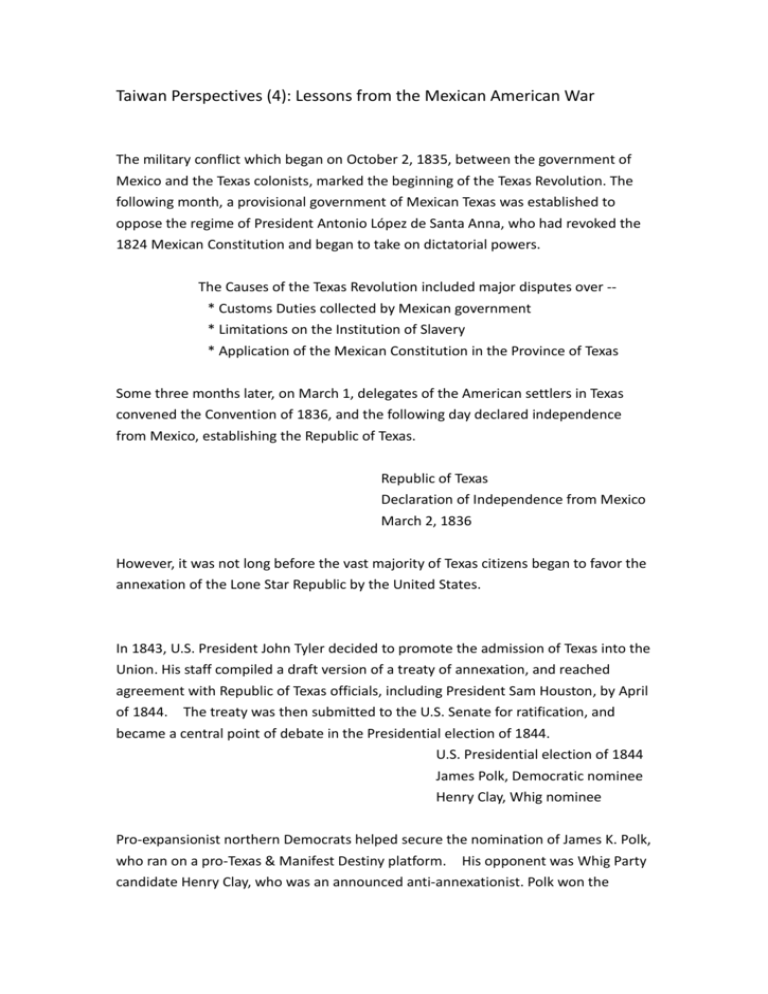
Taiwan Perspectives (4): Lessons from the Mexican American War The military conflict which began on October 2, 1835, between the government of Mexico and the Texas colonists, marked the beginning of the Texas Revolution. The following month, a provisional government of Mexican Texas was established to oppose the regime of President Antonio López de Santa Anna, who had revoked the 1824 Mexican Constitution and began to take on dictatorial powers. The Causes of the Texas Revolution included major disputes over -* Customs Duties collected by Mexican government * Limitations on the Institution of Slavery * Application of the Mexican Constitution in the Province of Texas Some three months later, on March 1, delegates of the American settlers in Texas convened the Convention of 1836, and the following day declared independence from Mexico, establishing the Republic of Texas. Republic of Texas Declaration of Independence from Mexico March 2, 1836 However, it was not long before the vast majority of Texas citizens began to favor the annexation of the Lone Star Republic by the United States. In 1843, U.S. President John Tyler decided to promote the admission of Texas into the Union. His staff compiled a draft version of a treaty of annexation, and reached agreement with Republic of Texas officials, including President Sam Houston, by April of 1844. The treaty was then submitted to the U.S. Senate for ratification, and became a central point of debate in the Presidential election of 1844. U.S. Presidential election of 1844 James Polk, Democratic nominee Henry Clay, Whig nominee Pro-expansionist northern Democrats helped secure the nomination of James K. Polk, who ran on a pro-Texas & Manifest Destiny platform. His opponent was Whig Party candidate Henry Clay, who was an announced anti-annexationist. Polk won the election, succeeded Tyler, and entered the White House on March 4, 1845. James Polk 11th President of the United States In office: March 4, 1845 to March 4, 1849 In Texas, some four months later, an annexation convention was held, which resulted in the passing of the annexation proposals with a large majority on July 4, 1845. A state constitution, drawn up by the convention, was ratified by popular vote in October. President Polk then signed the federal legislation making the former Lone Star Republic the 28th state of the Union on Dec. 29, 1845. Texas joins the Union Dec. 29, 1845 28th state Surprisingly however, during the period of all of these negotiations, the border of Texas as an independent state, and later as a state in the USA, was never completely settled. Many historians cite one major cause of the Mexican American War as a territorial ownership dispute over a piece of land approx. 240 km (150 miles) wide in what is today the southern part of Texas, known as the Nueces Strip. The United States claimed that this land belonged to Texas; however Mexico said that this land was theirs. The Causes of the Mexican American War included major disputes over -* Location of the boundary line between Texas and Mexico * Admission of Texas to the Union as the 28th state * Unjust arrest and imprisonment of Americans in Mexican territory * Outstanding property claims by Americans against Mexico * Unwillingness of Mexican government to negotiate for resolution of these, and other, controversies On April 24, 1846, American forces were attacked near the Rio Grande. On May 13, the U.S. Congress declared war against Mexico. The Mexican American War During the course of the war, which lasted a little over two years, the United States military troops conducted actions against locations in Mexico both on land and by sea. Below we will discuss two situations of United States Military Government (USMG) jurisdiction over Mexican territory, in order to illustrate some important aspects of the customary laws of warfare. Tampico, Mexico In late October, 1846, under onslaught by the U.S. navy warships, Mexican forces in the port city of Tampico determined that their situation was indefensible, and abandoned the city. On November 14, U.S. troops captured the city without a fight. The U.S. flag was raised. In this way the military occupation of Tampico, Mexico began. Tampico, Mexico Captured: Nov. 14, 1846 Tampico, Mexico USMG begins: Nov. 14, 1846 In March and June of 1847, an import firm in Philadelphia, Pennsylvania, doing business under the name of Fleming and Marshall, imported various goods from Tampico into the United States. Import duties were assessed by U.S. customs officials. The firm disputed that such customs duties were collectable on goods imported from Tampico, and after failing to resolve their disagreement with the U.S. customs collector, James Page, then filed a lawsuit for recovery of the duties paid. Their rationale was that Tampico, Mexico, then under military occupation by U.S. military forces, was not a “foreign port” under the laws of the United States regarding the collection of import duties from overseas areas. This case was argued at several levels of the U.S. court system, eventually reaching the Supreme Court. The Court addressed several issues, including: Within the meaning of the acts of Congress regarding import duties to be assessed on goods from Mexico, or any part thereof, and within the customs and usages of war, -Whether (1) Tampico, in the year 1847, while in the military occupation of the forces of the United States, ceased to be in a foreign country, and therefore (2) whether during such military occupation, said acts of Congress did not apply to Tampico, but entitled the city to be treated in a similar fashion to a U.S. domestic port. Fleming v. Page U.S. Supreme Court (1850) After a thorough dissection of all relevant legal principles, the decision of the Justices held that after Tampico was subdued, it was still uniformly treated as an enemy's country. In other words, it remained a foreign port, even though the U.S. flag was flying. Indeed, after the conclusion of the treaty of peace, Tampico was promptly restored to the possession of the Mexican authorities. Under the laws and usages of war, during the period of its subjugation it was not proper for the United States to regard it as a part of U.S. domestic territory, or to give to it any form of civil government, or to extend to it our laws. The capture of the city did not mean that there was a transfer of the territorial sovereignty to the country of the arriving military forces. After capture, and during the period of military occupation, Tampico would be best classified as an independent customs territory under USMG on Mexican soil. The military forces of the occupying army were neither entitled to seize public or private property in the city, nor to promulgate an entirely new code of laws. Nor could they undertake a mass naturalization of the local inhabitants. The occupiers were required to follow the rules of usufruct usufruct -- (1) the right to the use and enjoyment of another's property and its profits, (2) the right to use and enjoy the profits and advantages of something belonging to another as long as the property is not damaged or altered in any way. California territory under USMG A more involved situation occurred in California territory, which was separated from Mexico in the peace treaty and ceded to the United States. Mexican forces had been defeated, and (Upper) California had been progressively occupied by U.S. military forces by late 1846, and early January 1847. United States Military Government (USMG) was in force, and the U.S. flag was flying. In 1848, after the conclusion of the treaty of peace with Mexico, an import firm doing business under the name of Cross, Hobson, & Co., imported various goods from foreign places into the United States. These goods were assessed import duties by U.S. military officials at the port of San Francisco. The firm disputed that such customs duties should be paid, and after failing to resolve their disagreement with the U.S. customs collector, Edward Harrison, then filed a lawsuit for recovery of these customs duties. Their rationale was that under international law and U.S. law, USMG established in California territory as a result of the Mexican American war could only operate while hostilities were in progress. Hence, after the conclusion of the treaty of peace with Mexico, there was no longer any legal basis for the operation of such a military government or the collection of customs duties by its officers in ports of California. This case was argued at several levels of the U.S. court system, eventually reaching the U.S. Supreme Court. The Court addressed several issues, among the most important of which was: Within the customs and usages of war, -Whether (1) the United States Military Government, established in California during the period of hostilities in the Mexican American War, did continue functioning past the date when the peace treaty came into effect, and (2) whether officials of such military government had the right to collect customs duties continuing past such date. Cross v. Harrison U.S. Supreme Court (1853) After lengthy debate, the decision of the Justices held that the government, of which Colonel Mason was the military governor, had its origin in the lawful exercise of a belligerent right over a conquered territory. It had been instituted during the war by the command of the President of the United States, James Polk. It was the government when the territory was ceded in the peace treaty, and it did not cease, as a matter of course, or as a necessary consequence of the restoration of peace. This is one of the most important concepts which we need to learn about military occupation, and indeed it is exactly what we saw in our previous overviews of the legal developments of Cuba, Guam, Puerto Rico, and the Philippines after the Spanish American War.. It may be summarized by saying that after war, in situations where a territory is separated from the “motherland” via the specifications of a peace treaty, the military government of the legal occupier does not end with the coming into force of that treaty. Procedures for Drafting a New Taiwan Constitution The decisions in the above cases are of excellent reference value for discussing the situation in Taiwan beginning in late October 1945. We can also learn about the correct procedures for drafting a new territorial constitution by examining the post-war developments from this period of the mid-1800s. As we know, over the last few decades, more and more people in Taiwan have begun to wonder why the native Taiwanese people cannot have their own constitution, in which all the Taiwanese Executive, Legislative, and Judicial government branches, and all subsidiary divisions, would be specified. In this way, the Taiwanese people could obtain a great deal of autonomy in dealing with their own affairs. In order to deal with this problem, many Taiwan independence advocates continually stress the need for the Taiwanese people to declare independence from “China.” However, such a stance is illogical. Taiwan was under Japanese sovereignty up until April 28, 1952, when the post-war San Francisco Peace Treaty came into force. In the treaty, Taiwan was not awarded to China. Since Taiwan is not a part of China, there is no need to declare independence from China. Clearly, the post WWII arrangements have left Taiwan under the jurisdiction of the United States Military Government (USMG), which means that Taiwan is, and continues to be, occupied territory of the United States. The so-called Republic of China government in Taiwan is merely serving as a proxy occupying force for the ongoing military occupation, while at the same time fulfilling the role of a government in exile. Here is a Chart which contrasts the legal status of [A] Taiwan territory, [B] the ROC in Taiwan, and [C] the USA in Taiwan for three crucial dates in modern Taiwanese history. Oct. 25, 1945 Dec. 10, 1949 April 28, 1952 The legal status An independent An independent A quasi-trusteeship under of Taiwan customs territory customs territory military government territory under USMG on under USMG on within the U.S. insular law Japanese soil Japanese soil framework (The administrative authority for the military occupation has been delegated to the Chinese Nationalists.) The legal status A proxy occupation A proxy occupation A proxy occupation force of the ROC in force for USMG force for USMG and for USMG and a a government in government in exile exile (Chinese Taipei) (Chinese Taipei) Taiwan The legal status The “conqueror” The “conqueror” and “The legal occupier” (aka of the USA in and hence “the hence “the legal “principal occupying Taiwan legal occupier” occupier” power”) If we look to the situation of the post Mexican American War period as an example, procedures should be established to select delegates to send to a local Constitutional Convention. The Constitutions of all the U.S. states formed out of (former) Mexican territory were drafted in local Constitutional Conventions held on the following dates. =========== Constitutional Conventions =========== Texas Constitution July 1845 California Constitution September 1849 Nevada Constitution July 1864 Colorado Constitution March 1876 Utah Constitution March 1895 Arizona Constitution October 1910 New Mexico Constitution November 1910 Military Governor of Taiwan Territory In the history of the United States, for territories still under military government after the peace treaty has come into force, the inhabitants do enjoy fundamental rights under the U.S. Constitution. Additionally, established precedent is for the local “military governor” to make a promulgation regarding the selection of delegates to a Constitutional Convention. After the constitution is drafted, it would then be given to the local electorate for approval. For Taiwan, we should note the following: The job description of the Director of the American Institute in Taiwan does not include any duties related to fulfilling the role of “military governor” over Taiwan territory. Hence, the person most properly situated to fulfill this role is undoubtedly the U.S. Secretary of Defense. Military Governor of Taiwan Territory U.S. Secretary of Defense Youtube .docx file

